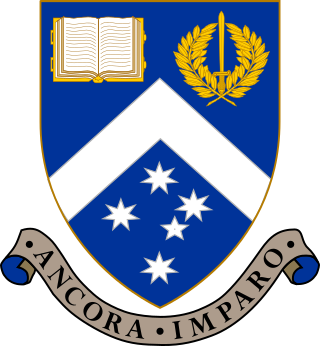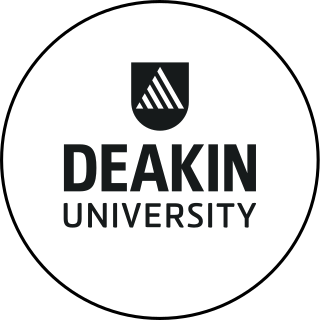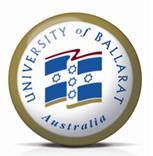Technical and further education or simply TAFE, is the common name in English-speaking countries in Oceania for vocational education, as a subset of tertiary education. TAFE institutions provide a wide range of predominantly vocational courses.

Victoria University is a public research university based in Melbourne, Victoria, Australia. It is one of only six dual-sector universities in Australia, providing courses in both higher education and Technical and Further Education (TAFE). 2016 marked VU's centenary as an educational institution and its 25th anniversary as a university.

Monash University is a public research university based in Melbourne, Victoria, Australia. Named for prominent World War I general Sir John Monash, it was founded in 1958 and is the second oldest university in the state. The university has a number of campuses, four of which are in Victoria, and one in Malaysia. Monash also has a research and teaching centre in Prato, Italy, a graduate research school in Mumbai, India and graduate schools in Suzhou, China and Tangerang, Indonesia. Monash University courses are also delivered at other locations, including South Africa.

The University of South Australia (UniSA) is a public research university in the Australian state of South Australia. It is a founding member of the Australian Technology Network of universities, and is the largest university in South Australia with approximately 37,000 students.

Deakin University is a public university in Victoria, Australia. Founded in 1974, the university was named after Alfred Deakin, the second Prime Minister of Australia.
The College of Advanced Education (CAE) was a class of Australian tertiary education institution that existed from 1967 until the early 1990s. They ranked below universities, but above Colleges of Technical and Further Education (TAFE) which offer trade qualification. CAEs were designed to provide formal post-secondary qualifications of a more vocational nature than those available from universities, chiefly in such areas as teaching, nursing, accountancy, fine art and information technology.

Horsham is a regional city in the Wimmera region of western Victoria, Australia. Located on a bend in the Wimmera River, Horsham is approximately 300 kilometres (190 mi) northwest of the state capital Melbourne. As of the 2021 Census, Horsham had a population of 20,429. It is the most populous city in Wimmera, and the main administrative centre for the Rural City of Horsham local government area. It is the eleventh largest city in Victoria after Melbourne, Geelong, Ballarat, Bendigo, Wodonga, Mildura, Shepparton, Warrnambool, Traralgon, and Wangaratta.

South West Institute of TAFE is the Technical and Further Education (TAFE) Institute located in the south west of the Australian state of Victoria.
Warrnambool Institute of Advanced Education (WIAE) was a college of advanced education in Warrnambool, Victoria, Australia.
Victoria College was a College of Advanced Education (CAE) in Melbourne, Australia. It was created as a result of the merger on 23 December 1981 of the State College of Victoria colleges at Burwood, Rusden and Toorak with the Prahran College of Advanced Education. In doing so, it became the largest College of Advanced Education in eastern Melbourne.
Federation University Australia Gippsland Campus is an Australian university campus located in the town of Churchill 142 km east of Melbourne. Its main neighbouring towns in the region are Morwell and Traralgon. Formerly a branch of Monash University, on 1 January 2014 it became part of Federation University Australia. Study areas at the campus include Arts ; Business; Education; Information Technology; Nursing; Midwifery; Sport, Outdoor and Physical Education; Psychology; Science; Engineering and Visual Arts.
Footscray High School is a multi-campus educational institution in Melbourne, Australia. Footscray College has formed a network with the University of Melbourne which gives students a better chance of getting into the University after they leave high school. The network provides opportunities for the college to enter into a structured program that focuses upon excellence in teaching and learning practice and the improvement of student learning outcomes.<
The Western standard gauge railway line is a standard-gauge railway line in western Victoria, Australia. Completed in 1995, it forms part of the Melbourne–Adelaide rail corridor and serves as the principal interstate rail link between Victoria and the western states. The line replaced a number of former broad gauge routes which were gauge converted, and today sees both intrastate and interstate freight traffic, as well as the twice weekly The Overland passenger service. Major towns on the route include Geelong, Ararat, Horsham and Dimboola.

Education in Victoria, Australia is supervised by the Department of Education and Training (DET), which is part of the State Government and whose role is to 'provide policy and planning advice for the delivery of education'. It acts as advisor to two state ministers, that for Education and for Children and Early Childhood Development.
The RMIT Redbacks are the sport collective of the Australian research University the Royal Melbourne Institute of Technology (RMIT), based at all campuses in Victoria and Ho Chi Minh City, Vietnam. The program is managed by the RMIT Sport team, part of RMIT Student Life.
Technical Education Centres (TEC) are purpose built centres for the delivery of practical secondary school and vocational education programs on a TAFE campus in the state of Victoria, Australia. They aim to attract young people 16–19 years of age to provide trade skills training while they complete a secondary school certificate. Each TEC is administered by the TAFE Institute it is a part of.

Federation University Australia is a public, multi-sector university based in Ballarat in Victoria, Australia. The university also has campuses in Ararat, Horsham, Stawell, Churchill, Berwick, and Brisbane, as well as online technical and further education (TAFE) courses and Horsham's higher education nursing program.

Education in Ballarat may be divided into a four groups: pre-school, primary education, secondary education and tertiary education. Ballarat is home to two universities and many primary and secondary schools. Entry to tertiary education for most students is through the Victorian secondary school system where students are ranked by the Australian Tertiary Admission Rank (ATAR) upon completion of Year 12.
The Victorian regional leagues are the eighth level of soccer in Victoria, Australia, and the ninth nationally. The league consists of eight separate regional senior leagues and is administered by the Football Federation Victoria.
The Prahran College of Advanced Education, formerly Prahran College of Technology, was a late-secondary and tertiary institution with a business school, a trade school, and a multi-disciplinary art school that dated back to the 1860s, populated by instructors and students who were among Australia’s significant artists, designers and performers.













